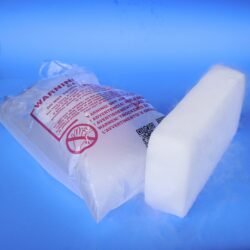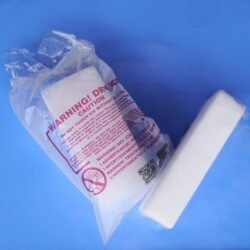Why Safe Disposal of Dry Ice is Important
Dry ice, the solid form of carbon dioxide (CO2), is widely used for its cooling properties in transportation, storage, and even in fun experiments. However, while dry ice is effective for freezing and cooling, it’s important to know how to properly dispose of it when you no longer need it. If not handled correctly, dry ice can pose safety hazards, particularly because it sublimates directly into CO2 gas. Improper disposal can lead to gas buildup, frostbite, or even dangerous situations in enclosed spaces.
Knowing how to dispose of dry ice safely is crucial for preventing accidents. This guide will walk you through the proper methods to discard dry ice, what mistakes to avoid, and where it’s safe to get rid of dry ice. Whether you’re using dry ice for industrial purposes or personal use, following the right disposal steps will keep everyone safe.
How to Dispose of Dry Ice Safely
When considering how dispose dry ice, it is essential to prioritize safety. The most effective method is to let dry ice sublimate in a well-ventilated area. This allows the solid to transform into gas safely, minimizing the risk of carbon dioxide buildup that can occur in confined spaces. To achieve this, take the dry ice outside or to a location with adequate airflow, ensuring that you avoid any enclosed areas where the gas could accumulate.
It is advisable to keep dry ice in its original packaging when disposing of it. This helps control the sublimation process and reduces the risk of direct contact, which can cause frostbite. Avoid disposing of dry ice down sinks or toilets, as the extreme cold can damage plumbing. By following these guidelines on how dispose dry ice, you can ensure a safe and responsible disposal process.
The Proper Way to Dispose of Dry Ice
If you’re wondering how to dispose of dry ice, the best and safest way is to allow it to sublimate naturally in a well-ventilated area. This means that the dry ice will turn directly into gas without leaving any liquid behind. To do this, simply place the dry ice in a space with good airflow, such as outside or in a room with open windows. Be sure the area is free of pets and children, as the extremely cold temperature of dry ice can cause harm if touched directly.
It’s important to avoid disposing of dry ice in confined or sealed spaces. As dry ice sublimates, it releases carbon dioxide gas, which can accumulate in enclosed areas and displace oxygen, creating a suffocation hazard. Therefore, do not dispose of dry ice in small rooms, garages, or vehicles where gas buildup could occur.
Additionally, never attempt to flush dry ice down the sink, toilet, or any plumbing system. The extreme cold could damage pipes, and the sublimation process could cause pressure buildup in enclosed systems. Also, don’t throw dry ice in the trash, as it can cause issues in sealed garbage containers due to gas buildup.
What Not to Do When Disposing of Dry Ice
- Don’t flush dry ice down the sink or toilet, as it can damage plumbing and cause dangerous gas buildup.
- Don’t dispose of dry ice in the trash, especially in sealed containers where gas can accumulate.
- Avoid disposing of dry ice in confined spaces where CO2 gas could displace oxygen.
By following these steps, you can ensure that you safely get rid of dry ice without any risk to yourself or others.
Where to Safely Get Rid of Dry Ice
Safe Areas for Dry Ice Disposal
When disposing of dry ice, it’s important to choose the right location to avoid any safety hazards. The best place to allow dry ice to sublimate is outdoors, where there’s plenty of ventilation and no risk of gas buildup. If disposing of it outdoors isn’t an option, choose a room with open windows or a space with good airflow to ensure the carbon dioxide gas disperses safely.
Make sure that the dry ice is placed on a surface where it won’t come into direct contact with anything that could be damaged by the cold, such as countertops or floors. It’s also important to keep the area clear of pets and children to avoid accidental contact with the dry ice, which can cause frostbite-like burns. Placing the dry ice on an insulated tray or in a container with ventilation is ideal, but never seal the container, as this could cause pressure to build up.
Importance of Avoiding Confined Spaces
One of the biggest mistakes people make when getting rid of dry ice is placing it in confined spaces. When dry ice sublimates, it releases carbon dioxide gas, which can accumulate and displace oxygen in small areas. This is particularly dangerous in enclosed spaces like garages, basements, or vehicles where there is limited airflow. In such conditions, a buildup of carbon dioxide can lead to suffocation risks, even if you aren’t in direct contact with the dry ice itself.
Therefore, always make sure to dispose of dry ice in well-ventilated areas where the gas can disperse naturally and safely. This simple precaution can prevent serious accidents from occurring, especially when dealing with larger amounts of dry ice.
How to Break Dry Ice
Breaking dry ice into smaller pieces helps speed up its sublimation, making disposal faster and more efficient. Before breaking, ensure you wear insulated gloves and safety goggles to protect against frostbite and flying debris. Place the dry ice on a sturdy surface, such as a wooden board, and lightly tap it with a hammer or mallet. This will break the block into manageable chunks.
By breaking the dry ice, you increase its surface area, allowing it to sublimate faster. Spread the smaller pieces in a well-ventilated outdoor area to safely allow the carbon dioxide to dissipate. Avoid using metal surfaces, as extreme cold can damage them. Never attempt to break dry ice with excessive force, as it may cause dangerous shards to fly off.
Common Mistakes When Disposing of Dry Ice
What Not to Do with Dry Ice
Disposing of dry ice improperly can lead to dangerous situations. Here are some of the most common mistakes people make when trying to get rid of dry ice, and why they should be avoided:
- Sealing Dry Ice in a Container: One of the biggest hazards comes from sealing dry ice in an airtight container. As dry ice sublimates and turns into gas, pressure can build up inside the container, causing it to burst or explode. Always leave room for the gas to escape.
- Throwing Dry Ice in the Trash: Dry ice should never be disposed of in the trash, especially in sealed bins or bags. The buildup of gas in a confined space can cause similar pressure problems and lead to hazardous situations.
- Pouring Dry Ice into Water: Although it may seem like a quick way to get rid of dry ice, placing it in water causes rapid sublimation, which can create too much gas too quickly and lead to splashing or spillage of dangerously cold water.
- Leaving Dry Ice in Unventilated Areas: As mentioned earlier, sublimating dry ice in a closed or poorly ventilated space is dangerous because of the risk of carbon dioxide gas buildup. Always dispose of dry ice in an open, ventilated area.
Avoiding these common mistakes will ensure that you’re disposing of dry ice safely and effectively.
How to Handle Leftover Dry Ice
Tips for Storing and Disposing of Leftover Dry Ice
If you have leftover dry ice that you don’t need immediately, it’s important to store it properly before disposal. Always keep dry ice in a well-ventilated area to prevent carbon dioxide buildup and ensure that it is kept away from direct contact with other items. If possible, use an insulated container, such as a cooler, to slow the sublimation process. However, remember to leave the container slightly open to allow the gas to escape.
If you no longer need the dry ice, follow the guidelines for safe disposal by allowing it to sublimate in an open, well-ventilated space. Do not try to freeze it for future use, as dry ice will sublimate even when stored in a freezer. By letting it turn into gas naturally, you’ll safely discard any leftover dry ice without creating hazards.
Why You Shouldn’t Throw Dry Ice in the Trash
The Dangers of Throwing Dry Ice in the Trash
One of the most dangerous mistakes people make when disposing of dry ice is throwing it in the trash. Sealed garbage bins or bags do not provide the necessary ventilation for the carbon dioxide gas to escape, leading to a buildup of pressure. This can result in dangerous situations, including the possibility of explosions or damage to the trash bin.
Additionally, garbage collectors may unknowingly come into contact with the dry ice, which can cause frostbite or burns. To prevent these risks, always dispose of dry ice by allowing it to sublimate in a safe, open area. This method ensures the dry ice turns into gas naturally without harming people or the environment.
Conclusion
Safely disposing of dry ice is essential for avoiding dangerous situations caused by improper handling. The best way to discard dry ice is to allow it to sublimate in a well-ventilated area, ensuring that the gas disperses without causing harm. Avoid common mistakes like sealing dry ice in containers, flushing it down sinks, or throwing it in the trash.
By following these guidelines, you can safely get rid of dry ice without any risk. For those who frequently use dry ice for cooling or freezing purposes, Sub Zero Dry Ice offers a range of products and resources to help you manage and dispose of dry ice responsibly. Make sure to follow these best practices every time you need to discard dry ice!




